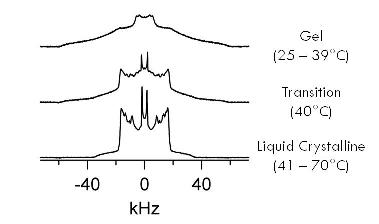About Our Lab
Cell membranes are complex assemblies of lipids and proteins held together by lipids' natural tendency to form bilayer structures. Nearly all biological membranes exist in a liquid crystalline 'bilayer' physical state, where membrane components can diffuse within their monolayer but cannot spontaneously hop to the other side of the membrane.
Since lipids are amphiphilic and water - the biological solvent - is polar, lipids tend to spontaneously self assemble into supramolecular aggregates. The hydrophilic lipid heads like to position themselves in such a way that they are hydrated by the water while keeping the hydrophobic ends tucked away.
Two examples of lipid aggregates are the micelle and the lipid bilayer that comprises the bulk of all cellular membranes. As Ole Mouritsen states in his book, Life-As A Matter Of Fat, "membranes are self-assembled molecular aggregates in which subtle elements of structure arise out of a state of substantial disorder, and where entropy consequently plays a major role."
Model membrane systems are made by mixing several membrane components together to roughly mimicking a specific biological membrane. We are interested in mapping out the fundamental interactions between phospholipids, sterols and sphingolipids in model membranes having defined compositions. Our tool of choice is deuterium NMR since the NMR spectra can clearly distinguish between the different physical states of membranes.
Deuterium nuclear magnetic resonance (NMR) is a powerful experimental approach to the study of phase coexistence in membranes: different phases result in clearly distinguishable spectra, and the quantity of labeled lipid in a particular phase can be measured unambiguously. Importantly, deuterium NMR does not rely on large unnatural probes to monitor membrane domains, as even small amounts of such probes can modify domain properties.
The knowledge gained from the work we do aids cell biologists investigating phenomena related to membrane domains, e.g. programmed cell death, protein localization/signaling, neuronal maturation and bacterial/viral infection.
